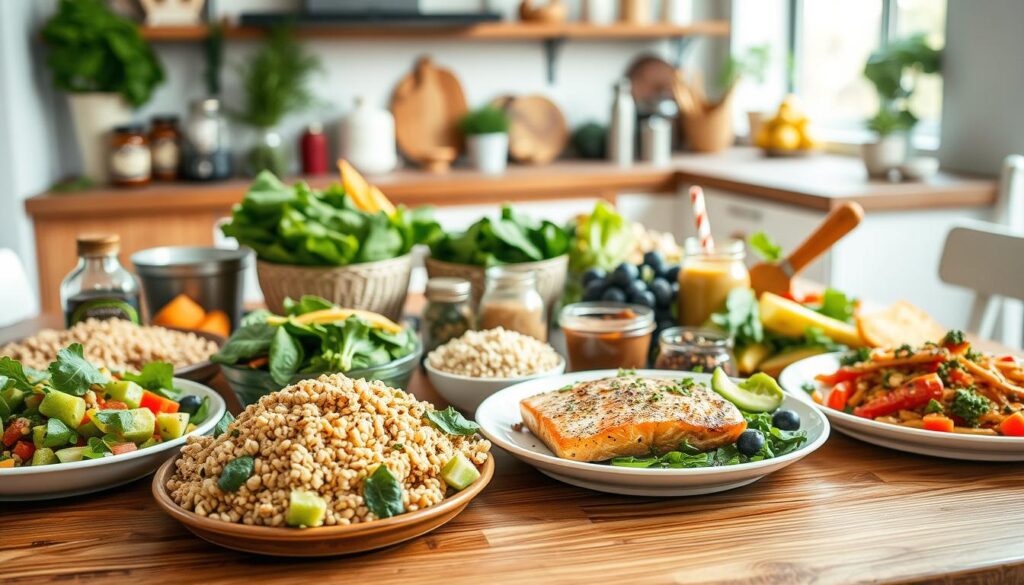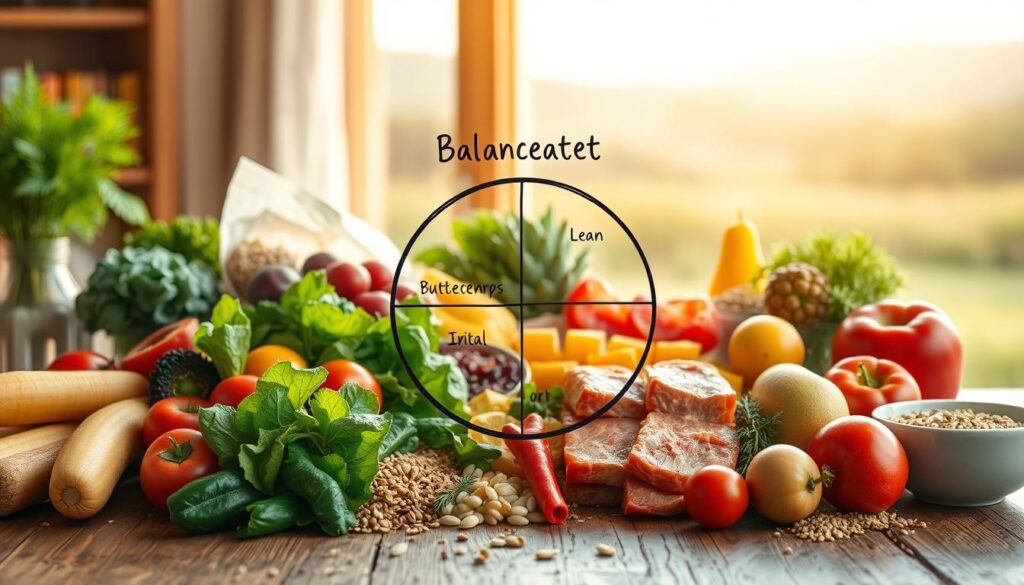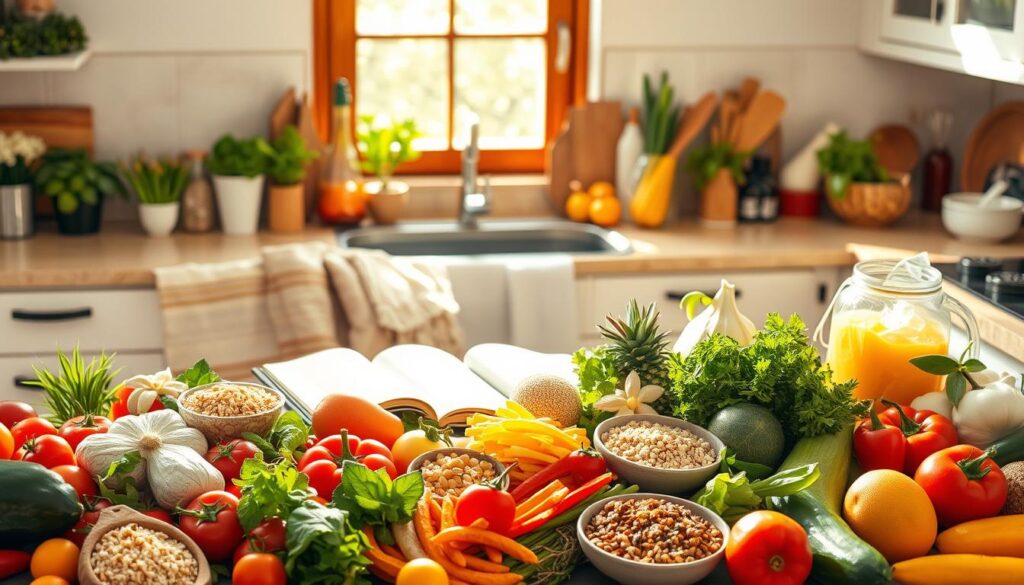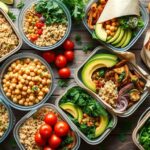The Best Fluffy Pancakes recipe you will fall in love with. Full of tips and tricks to help you make the best pancakes.
Having a healthy weekly meal plan is key to a balanced diet. It saves time and money and boosts your health. By planning meals ahead, you get the nutrients you need to stay energized and focused. This article will show you the benefits and give you easy recipes and meal prep ideas to start.
With a healthy meal plan, you can enjoy tasty and nutritious meals all day. You’ll learn how to make a meal plan that fits your lifestyle and tastes. We aim to help you make healthy eating a daily habit.

A healthy meal plan is more than just cooking. It’s about making choices that improve your well-being. Meal prep can reduce stress, boost energy, and clear your mind. It’s great for busy people or athletes looking to stay balanced.
Key Takeaways
- Creating a healthy weekly meal plan can help you save time and money
- Meal prep ideas can improve your overall health and well-being
- A healthy weekly meal plan can include a variety of breakfast, lunch, dinner, and snack options
- Planning your meals in advance can help you make healthy choices and reduce stress
- Incorporating meal prep ideas into your daily routine can increase energy and improve mental clarity
- A healthy weekly meal plan can be tailored to suit your lifestyle and preferences
Getting Started with Meal Planning Fundamentals
To start easy meal planning, you need to know the basics. It’s about making a plan that fits your life and tastes. First, figure out your diet goals and the recipes you like.
Having the right kitchen tools is key for easy meal planning. You’ll need a slow cooker, sharp knives, and various pots and pans. These help you cook healthy meals quickly and well.
Essential Kitchen Tools and Equipment
Here are some must-have items for your kitchen:
- Slow cooker
- Sharp knives
- Pots and pans
- Colander
- Measuring cups and spoons
Creating Your Shopping List
Making a shopping list is a big part of meal planning. Plan your meals for the week and list the ingredients you need. Make sure to include a variety of healthy recipes.
Time-Saving Preparation Techniques
Techniques like meal prep and batch cooking save time in the kitchen. Here’s a meal prep example:
| Meal | Ingredients | Cooking Time | Calories per Serving |
|---|---|---|---|
| Grilled Chicken | Chicken breast, olive oil, salt, and pepper | 20 minutes | 350 |
| Roasted Vegetables | Broccoli, carrots, olive oil, salt, and pepper | 25 minutes | 100 |
By using these tips and adding healthy recipes to your plan, you can eat well and stay balanced. It’s all about finding what works for you.
Understanding Balanced Nutrition for Optimal Health
To stay healthy, it’s key to eat a balanced diet plan with lots of nutrient-rich foods. A good diet gives your body what it needs to work right. Think about protein, carbs, and healthy fats when planning your meals.
Eating well has many benefits. It helps with weight, boosts energy, and lowers disease risk. Include fruits, veggies, whole grains, lean proteins, and healthy fats in your diet. Avoid processed and sugary foods, which are bad for you.

- Eating a variety of colorful fruits and vegetables to ensure adequate vitamin and mineral intake
- Incorporating lean protein sources, such as poultry, fish, and legumes, into your meals
- Choosing whole grains, like brown rice, quinoa, and whole-wheat bread, instead of refined grains
- Limiting your intake of saturated and trans fats, added sugars, and refined carbohydrates
By following these tips and making a balanced diet plan, you can get healthier. This reduces disease risk and helps keep a healthy weight. Drink lots of water and cut down on sugary drinks.
| Nutrient | Food Sources | Benefits |
|---|---|---|
| Protein | Lean meats, fish, eggs, legumes | Builds and repairs tissues, supports immune function |
| Carbohydrates | Whole grains, fruits, vegetables | Provides energy, supports healthy digestion |
| Healthy Fats | Nuts, seeds, avocados, olive oil | Supports heart health, aids in nutrient absorption |
Your Complete Healthy Weekly Meal Plan Guide
To make a healthy weekly meal plan, think about what you like to eat and your dietary needs. Meal prep can save you time and money. It also helps you get the nutrients you need to stay healthy.
It’s important to have different meal prep ideas. Plan your breakfast, lunch, dinner, and snacks. For instance, try overnight oats for breakfast, a salad with lean protein for lunch, and grilled chicken with roasted veggies for dinner.

Breakfast Options and Recipes
- Avocado toast with scrambled eggs
- Greek yogurt with berries and granola
- Smoothie bowl with spinach, banana, and almond milk
These breakfasts are tasty and full of good stuff like protein, healthy fats, and carbs. Adding meal prep to your day makes healthy eating simpler and more convenient.
Nutrient-Packed Lunch Ideas
Your meal plan should have lots of healthy lunch options. Try a whole grain pita with roasted turkey, avocado, and greens, or a quinoa salad with grilled chicken, cherry tomatoes, and cucumber.
Conclusion: Making Your Meal Plan Work Long-Term
Adding a balanced diet plan with nutritious recipes to your life is a big step towards better health. A healthy meal plan gives your body the structure, variety, and nutrition it needs. But, the real challenge is making it last.
To keep meal planning fun and easy, try new recipes and get your family involved. Celebrate your successes too. Remember, this is a journey, not a quick fix. Be patient and kind to yourself.
If you get stuck, look for help online, in cookbooks, or from a dietitian. These resources can offer great advice and motivation. Your health is worth the effort, so enjoy the journey to a balanced, nutritious lifestyle.
What are the benefits of a healthy weekly meal plan?
A healthy weekly meal plan saves time and money. It also boosts your health and keeps your diet balanced. Planning meals ahead means you won’t waste food or grab unhealthy takeout.
How do I create a balanced meal plan?
To make a balanced meal plan, include foods rich in nutrients. This means lean proteins, whole grains, fruits, veggies, and healthy fats. Make sure each meal has a mix of carbs, protein, and fat. Think about what you like and need.
What are some essential kitchen tools and equipment for meal planning?
Key tools for meal planning include a stocked pantry and meal prep containers. You’ll also need a slow cooker, food processor, and sharp knives. These help you prepare and store meals efficiently.
How can I save time with meal prep and batch cooking?
Meal prep and batch cooking save a lot of time. Start by prepping ingredients early. Cook big batches of meals to portion out later. Use shortcuts like roasting veggies or cooking grains in bulk.
What are some healthy breakfast, lunch, and dinner options to include in my weekly meal plan?
Healthy breakfasts include overnight oats, frittatas, and smoothie bowls. For lunch, try hearty salads, whole grain wraps, or grilled chicken with veggies. For dinner, choose lean proteins, whole grains, and lots of fresh produce, like baked salmon with sweet potatoes and broccoli.
How can I incorporate balanced snacking into my weekly meal plan?
Healthy snacking is key to a balanced meal plan. Good snacks are fresh fruit with yogurt, raw veggies with hummus, or nuts. Having these ready can stop you from eating unhealthy foods.





